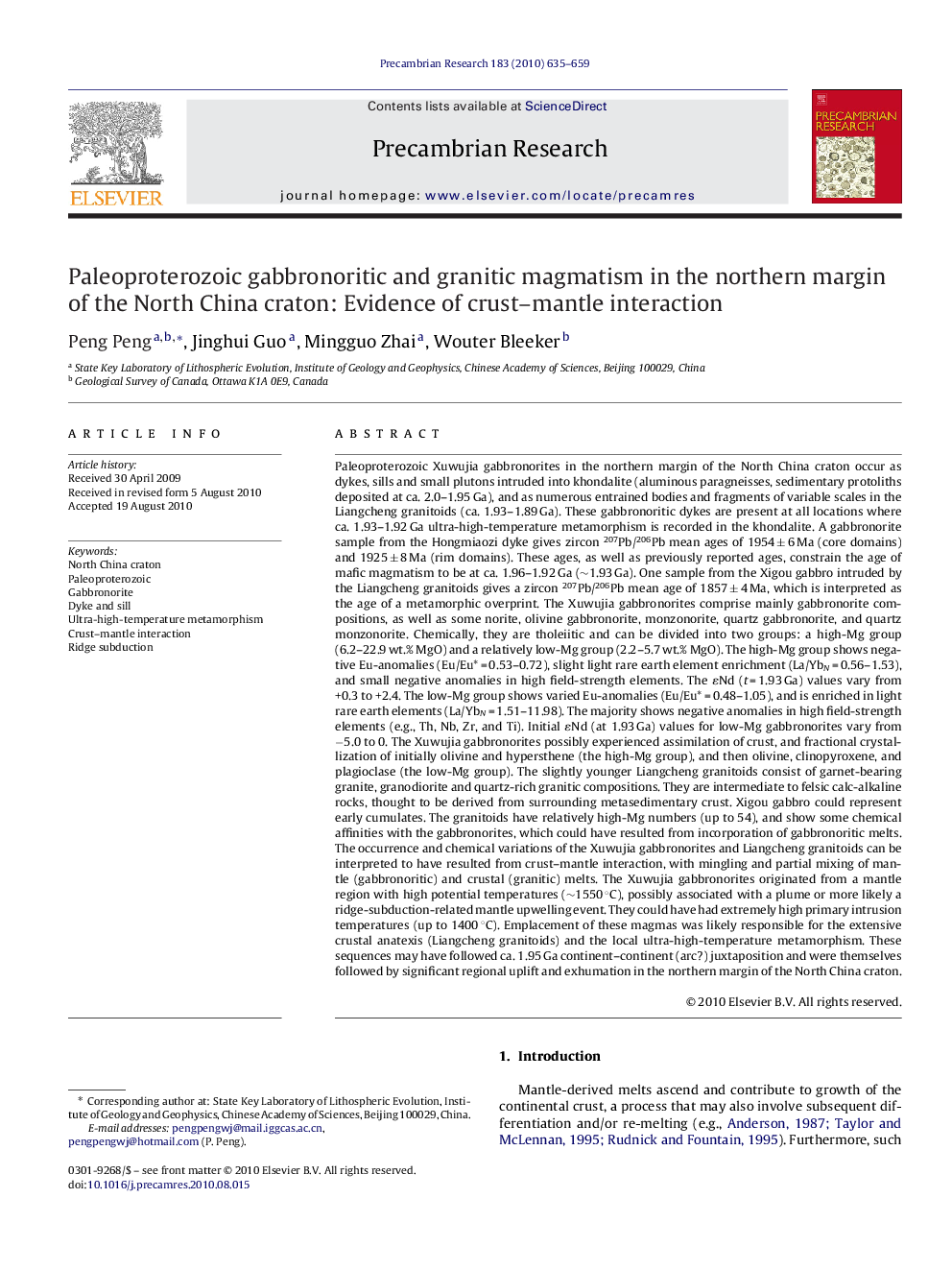| کد مقاله | کد نشریه | سال انتشار | مقاله انگلیسی | نسخه تمام متن |
|---|---|---|---|---|
| 4723729 | 1355543 | 2010 | 25 صفحه PDF | دانلود رایگان |

Paleoproterozoic Xuwujia gabbronorites in the northern margin of the North China craton occur as dykes, sills and small plutons intruded into khondalite (aluminous paragneisses, sedimentary protoliths deposited at ca. 2.0–1.95 Ga), and as numerous entrained bodies and fragments of variable scales in the Liangcheng granitoids (ca. 1.93–1.89 Ga). These gabbronoritic dykes are present at all locations where ca. 1.93–1.92 Ga ultra-high-temperature metamorphism is recorded in the khondalite. A gabbronorite sample from the Hongmiaozi dyke gives zircon 207Pb/206Pb mean ages of 1954 ± 6 Ma (core domains) and 1925 ± 8 Ma (rim domains). These ages, as well as previously reported ages, constrain the age of mafic magmatism to be at ca. 1.96–1.92 Ga (∼1.93 Ga). One sample from the Xigou gabbro intruded by the Liangcheng granitoids gives a zircon 207Pb/206Pb mean age of 1857 ± 4 Ma, which is interpreted as the age of a metamorphic overprint. The Xuwujia gabbronorites comprise mainly gabbronorite compositions, as well as some norite, olivine gabbronorite, monzonorite, quartz gabbronorite, and quartz monzonorite. Chemically, they are tholeiitic and can be divided into two groups: a high-Mg group (6.2–22.9 wt.% MgO) and a relatively low-Mg group (2.2–5.7 wt.% MgO). The high-Mg group shows negative Eu-anomalies (Eu/Eu* = 0.53–0.72), slight light rare earth element enrichment (La/YbN = 0.56–1.53), and small negative anomalies in high field-strength elements. The ɛNd (t = 1.93 Ga) values vary from +0.3 to +2.4. The low-Mg group shows varied Eu-anomalies (Eu/Eu* = 0.48–1.05), and is enriched in light rare earth elements (La/YbN = 1.51–11.98). The majority shows negative anomalies in high field-strength elements (e.g., Th, Nb, Zr, and Ti). Initial ɛNd (at 1.93 Ga) values for low-Mg gabbronorites vary from −5.0 to 0. The Xuwujia gabbronorites possibly experienced assimilation of crust, and fractional crystallization of initially olivine and hypersthene (the high-Mg group), and then olivine, clinopyroxene, and plagioclase (the low-Mg group). The slightly younger Liangcheng granitoids consist of garnet-bearing granite, granodiorite and quartz-rich granitic compositions. They are intermediate to felsic calc-alkaline rocks, thought to be derived from surrounding metasedimentary crust. Xigou gabbro could represent early cumulates. The granitoids have relatively high-Mg numbers (up to 54), and show some chemical affinities with the gabbronorites, which could have resulted from incorporation of gabbronoritic melts. The occurrence and chemical variations of the Xuwujia gabbronorites and Liangcheng granitoids can be interpreted to have resulted from crust–mantle interaction, with mingling and partial mixing of mantle (gabbronoritic) and crustal (granitic) melts. The Xuwujia gabbronorites originated from a mantle region with high potential temperatures (∼1550 °C), possibly associated with a plume or more likely a ridge-subduction-related mantle upwelling event. They could have had extremely high primary intrusion temperatures (up to 1400 °C). Emplacement of these magmas was likely responsible for the extensive crustal anatexis (Liangcheng granitoids) and the local ultra-high-temperature metamorphism. These sequences may have followed ca. 1.95 Ga continent–continent (arc?) juxtaposition and were themselves followed by significant regional uplift and exhumation in the northern margin of the North China craton.
Journal: Precambrian Research - Volume 183, Issue 3, 1 December 2010, Pages 635–659